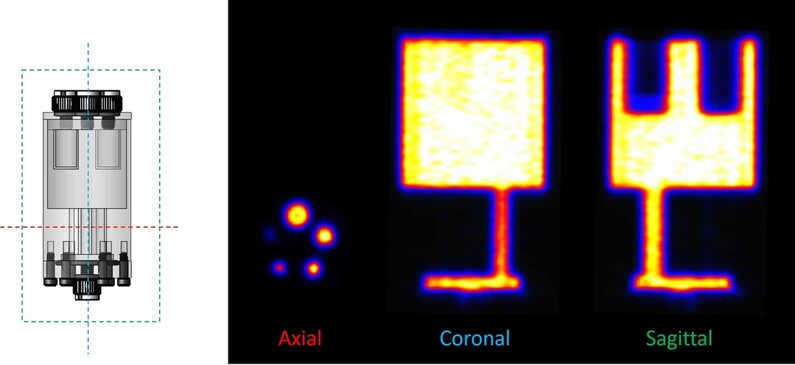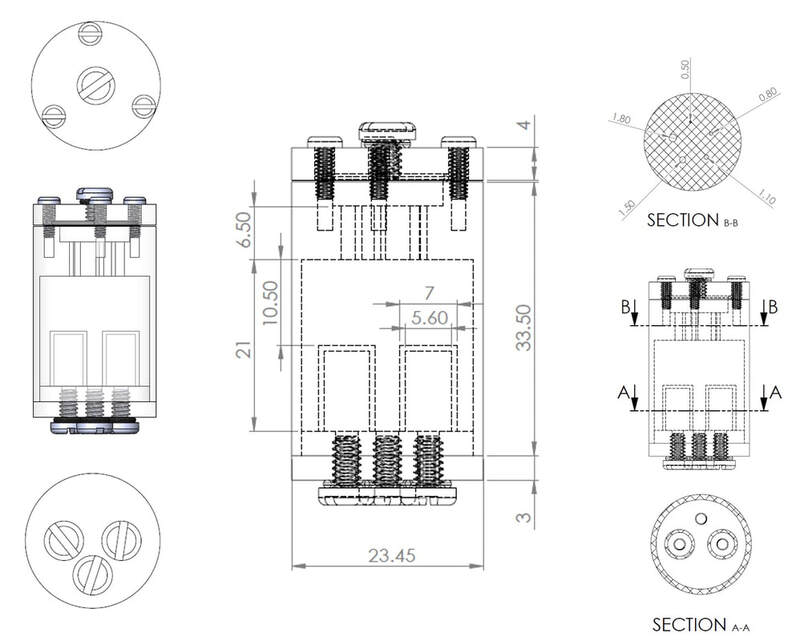Phantech has economical phantoms that adhere to the National Electrical Manufacturers Association (NEMA) standards. Assembled with three main pieces and associated hardware, these standard NEMA phantoms are available in two configurations: NEMA NU4-2008 (NU4IQ) and SPECT-IQ (as detailed in E.P. Visser et al. 2011, Nuclear Instruments and Methods in Physics Research A). These standard phantoms feature three fillable regions that allow the assessment of PET or SPECT scanner image quality (IQ) by representing typical hot, cold and uniform radioactivity in an animal (see below for more info).
Available Sizes
NEMA NU 4-2008 Phantom
Drawings and dimensions (units in mm)
PET Images (F-18)
SPECT-IQ Phantom
Drawings and dimensions (units in mm)
Size Comparison
Additional Info
NEMA NU 4-2008 Additional Info
The National Electrical Manufacturers Association (NEMA)) developed the NEMA NU-4 2008 standard in order to assess the performance of small animal Positron Emission Tomographs (PET) systems regardless of their camera setup. Per the scope of this NEMA standard, “[c]amera designs such as circular ring geometry of discrete crystal or continuous block detectors, planar detector (rotating or stationary), continuous crystals, gas avalanche detectors, time-of-flight or no time-of-flight, single slice or multi-slice dedicated PET tomographs and other coincidence capable imaging systems are covered by this procedure.”
The NU4IQ phantom has a main body that is fillable with ~20.5mLs of a homogenous concentration of radioactivity. Adjacent to it is solid non-radioactive material with five radioactive fillable rods varying in diameter from 1-5mm. The lid to the large homogenous volume contains two chambers of ~0.75mLs that are filled with either non-radioactive water or air. With these compartments, one can assess the spatial resolution, recovery coefficient, uniformity, signal-to-noise, attenuation, scatter correction, spill-over, and scatter correction performance of a preclinical PET scanner.
Reference: NEMA, National Electrical Manufacturers Association, NEMA Standards Publication NU 4-2008. Rosslyn, VA, National Electrical Manufacturers Association, 2008
The NU4IQ phantom has a main body that is fillable with ~20.5mLs of a homogenous concentration of radioactivity. Adjacent to it is solid non-radioactive material with five radioactive fillable rods varying in diameter from 1-5mm. The lid to the large homogenous volume contains two chambers of ~0.75mLs that are filled with either non-radioactive water or air. With these compartments, one can assess the spatial resolution, recovery coefficient, uniformity, signal-to-noise, attenuation, scatter correction, spill-over, and scatter correction performance of a preclinical PET scanner.
Reference: NEMA, National Electrical Manufacturers Association, NEMA Standards Publication NU 4-2008. Rosslyn, VA, National Electrical Manufacturers Association, 2008
SPECT-IQ Additional Info
The SPECT-IQ phantom is essentially the NEMA NU-4 2008 phantom scaled down by 70 percent. However, the rod diameters are specifically chosen to be 0.35, 0.5, 0.75, 1.0 and 1.5 mm to accommodate the higher resolution capabilities of small animal SPECT scanners.
With these compartments, one can assess the spatial resolution, recovery coefficient, effective whole-body sensitivity, uniformity, signal-to-noise, attenuation, scatter correction, spill-over, and scatter correction performance of a preclinical SPECT scanner. Additionally, since there is a tradeoff between resolution and sensitivity with different collimators, one can use this phantom to characterize collimators in order to choose the most appropriate collimator for a specific application. Lastly, this phantom can be used to assist in making decisions for acquisition and image reconstruction parameters. For example, one can scan this phantom to determine the ideal number of iterations to use in a reconstruction that would recover enough signal to resolve small structures but would not introduce too much noise.
Reference: E.P. Visser, et al., Nucl. Instr. and Meth. A (2011), doi:10.1016/j.nima.2011.06.036
With these compartments, one can assess the spatial resolution, recovery coefficient, effective whole-body sensitivity, uniformity, signal-to-noise, attenuation, scatter correction, spill-over, and scatter correction performance of a preclinical SPECT scanner. Additionally, since there is a tradeoff between resolution and sensitivity with different collimators, one can use this phantom to characterize collimators in order to choose the most appropriate collimator for a specific application. Lastly, this phantom can be used to assist in making decisions for acquisition and image reconstruction parameters. For example, one can scan this phantom to determine the ideal number of iterations to use in a reconstruction that would recover enough signal to resolve small structures but would not introduce too much noise.
Reference: E.P. Visser, et al., Nucl. Instr. and Meth. A (2011), doi:10.1016/j.nima.2011.06.036





